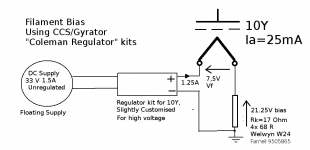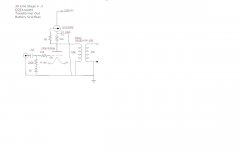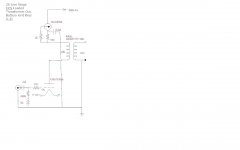Hi!
Better yet LCL, keeps a nasty electrolytic away from the signal path. Lundahl offers nice filament chokes. A LL2733 gapped for 1A will have 600mH. This provides excellent isolation of the filament from the PSU. With a 40.000uF cap between the two Ls this will be hum free.
Best regards
Thomas
Buffering between filament and supply is important. The DHT filament is susceptible to common-mode disturbance & noise from the filament PSU, and adding isolation to the -Ve side (as well as the positive) improves it still further! This is one of the aims of my regulators - both sides are buffered, without allowing the anode-current to enter the feedback loop of the heating current.
Hello Rabotnik Rod,
I can vouch for how good sounding Rod's boards are. Extremely well thought through. I should have mentioned them. I'm a bit fixated on the choke input solution since I bought a batch of 280mH chokes as a job lot, and they do sound good. But a high Dunker Factor solution which I'm sure many would like to avoid.
Rod - do you have a solution for filament bias? I'd be very interested!
Andy
I can vouch for how good sounding Rod's boards are. Extremely well thought through. I should have mentioned them. I'm a bit fixated on the choke input solution since I bought a batch of 280mH chokes as a job lot, and they do sound good. But a high Dunker Factor solution which I'm sure many would like to avoid.
Rod - do you have a solution for filament bias? I'd be very interested!
Andy
filament bias + heating
Hello Andy, always like to hear your enthusiasm for the 26 linestage!
Manu asked for a filament bias solution last week, and I'm due to test it now.
The standard regulator can be used, with a couple of signal transistors uprated for voltage durability.
Here's a sketch for Manu's 10Y stage. The voltage can be increased for solutions with supply voltages at 70V (!) or even more.
The supply is buffered from the filament on both sides, for best isolation, and the regulator works exactly as the standard version, to give the same good sound.
Hello Andy, always like to hear your enthusiasm for the 26 linestage!
Manu asked for a filament bias solution last week, and I'm due to test it now.
The standard regulator can be used, with a couple of signal transistors uprated for voltage durability.
Here's a sketch for Manu's 10Y stage. The voltage can be increased for solutions with supply voltages at 70V (!) or even more.
The supply is buffered from the filament on both sides, for best isolation, and the regulator works exactly as the standard version, to give the same good sound.
Attachments
Hi Andy,
I see. The step down output transformer offers the additional benefit of the ability to place a low impedance volume control, preferably a TVC, on the output of the linestage. This offers actually the biggest sonic benefit IMHO. Plus the low impedance output which makes the sonic result less prone to influences from the cables to the power amps.
Best regards
Thomas
The reason for using a 1:1 is purely gain - this would imply short cables and an input impedence of the next stage of 100k or over. Perfectly possible.
I know you use step-up transformers in your arrangement. That's a clever solution. Mine doesn't aspire to such sophistication, and just keeps it on a very basic and simple level - i.e. that you situate the line stage next to the amp.
I see. The step down output transformer offers the additional benefit of the ability to place a low impedance volume control, preferably a TVC, on the output of the linestage. This offers actually the biggest sonic benefit IMHO. Plus the low impedance output which makes the sonic result less prone to influences from the cables to the power amps.
Best regards
Thomas
Hi Andy,
Not necessarily in all and each of my amps. I'm also not fixated on DHTs only. It depends on the application and the budget. Especially since I offer many of my design commercially, either as kit or assembled. I need to have amps which are flexible and usable with other preamps and sources which might not be able to drive a input transformer well.
Of course I prefer DHTs throughout the signal chain. But I only use them, when all the rest is at high level already. I can perfectly enjoy music with some of my all indirectly heated tube amps as well.
Best reagards
Thomas
I know you use step-up transformers in your arrangement.
Not necessarily in all and each of my amps. I'm also not fixated on DHTs only. It depends on the application and the budget. Especially since I offer many of my design commercially, either as kit or assembled. I need to have amps which are flexible and usable with other preamps and sources which might not be able to drive a input transformer well.
Of course I prefer DHTs throughout the signal chain. But I only use them, when all the rest is at high level already. I can perfectly enjoy music with some of my all indirectly heated tube amps as well.
Best reagards
Thomas
Hi -
To come back to Rod. My own setup uses a 10 ohm cathode resistor and approx. 20v on the filament supply output. I'm in for a couple of your boards to try this out. I had a lot of problems with LM1084 switching off.
I'm wondering if I can use a filament choke before your reg? Since I have a few it would be good to use them.
Andy
To come back to Rod. My own setup uses a 10 ohm cathode resistor and approx. 20v on the filament supply output. I'm in for a couple of your boards to try this out. I had a lot of problems with LM1084 switching off.
I'm wondering if I can use a filament choke before your reg? Since I have a few it would be good to use them.
Andy
Thanks Andy, The LT108x regs have a current limit that goes negative-resistance on you at around 22V. With a cold filament, the load resistance is low, and oscillation is very likely. That in turn heats the chip & triggers the current-limit and/or the overtemp cutout.
I have found that the filament supplies benefit from added isolation always. I have not found where the limit to this benefit lies. Isolation transformers are worth the trouble, for instance. If you have some big chokes, they would certainly be worth trying. In this case, an added cap, near the regulator, is recommended.
I have found that the filament supplies benefit from added isolation always. I have not found where the limit to this benefit lies. Isolation transformers are worth the trouble, for instance. If you have some big chokes, they would certainly be worth trying. In this case, an added cap, near the regulator, is recommended.
Let me know when your board is available for filament bias. email me on performanceandmedia@gmail.com and I'll pay you money!
Andy
Andy
Some extra fun can be had with filament bias: you can use the fine-adjust of the filament current to fine tune the DHT's cathode bias. There's a high-quality 25-turn trimmer to adjust the filament current either side of the nominal.
Should be OK to operate a 26 filament between 1.40 and 1.55V anyway, and gives some bias tuning between cathode-resistor values!
Should be OK to operate a 26 filament between 1.40 and 1.55V anyway, and gives some bias tuning between cathode-resistor values!
Hi!
Best regards
Thomas
Agree! I always use separate transformers on my filament supplies. I get them custom wound with dual screen windings between primary and secondary and on grain oriented core material.I have found that the filament supplies benefit from added isolation always. I have not found where the limit to this benefit lies. Isolation transformers are worth the trouble, for instance.
choke input supply after the rectifier certianly is worth trying. You can use just a small cap after the rectifier (maybe 100-200uF) this helps to tame switchover between the diodes but keeps the choke input caharacteristic of the supplyIf you have some big chokes, they would certainly be worth trying. In this case, an added cap, near the regulator, is recommended.
Best regards
Thomas
Yes, that will work since it bypasses the CCS and reduces its impedance to zero.
Do you think this results in a circuit that is more or less preferable to a standard parafeed configuration? In my earlier attempts I was going for the PSRR of the CSS but trying to avoid a big cap. BTW George I discovered the IXY CCS on your site and have had fun playing with them ever since.
Attached is the next version. I have gone to battery bias, hopefully implemented correctly and added the 10uf to ground from the output of the ccs.
Attachments
You post and George's (tubelab) post may have crossed. But anyway. Here's an intuitive way of thinking about it:
A CCS has high output impedance. Its job is to keep the current constant regardless of what voltage is across it. Basically, as the anode voltage of the tube changes, the transformer primary will "ride the wave". As the anode voltage rises, the voltage across the CCS will be reduced by a similar amount, and the voltage across the primary of the transformer hardly changes. Hence, no change in voltage on the secondary side --> no sound output.
Adding a big cap from the CCS output to ground will reduce the AC impedance at that node to zero (close to anyway). So now for AC signals, the voltage stays put and you get the full anode voltage swing developed across the primary of the transformer.
Fair enough. The idea wasn't immediately intuitive to me, but that doesn't make it wrong. In that case, I'd probably build it like a power stage. Scrap the top resistor and the CCS. Connect the tube anode to the primary of the tranny and the B+ to the other side of the primary. Voila.
Then you have to figure out how to bias the darn thing. I'll leave that as an exercise for the reader...Actually, KevinK described it well, you just need to look up the terms and figure out what he meant. That's part of the learning experience...
The 26 is a directly heated triode, right? In that case definitely go with the DC filaments. Definitely... Start with something basic like an LM317 (assuming it can supply the current).
~Tom
thanks for explanations tom. Oops I thought I was setting bias with the resister to ground at the filament! i ordered the Morgan Jones.
While you're here on DIYaudio, have a look at the thread '#26 preamp'. There are many design tips here, simple and advanced. Battery bias, cathode bias, even filament-current bias. The use of current-sources with the #26. The DIYers on this thread have made some fine preamps with this DHT, and shared their findings.
http://www.diyaudio.com/forums/tubes-valves/151421-26-pre-amp.html
The 26 filaments certainly need dc heating, or humm will be unbearable. The #26 is sensitive to tiny changes in the quality of the filament-supply, as you can see in the thread. Sadly, the 3-terminal IC regulators don't sound good in this position - they are too noisy, and their structure causes the anode-current to be influenced by the regulation of the filament current (transients & noise in a 1.05A current can do a lot of damage to a <1mA signal current!). My double-buffered solution for heating DHTs is used by some of the builders - still some kits for these available.
i am concerned about the filament hum issues described and the relative complexity/cost involved in attempting to alleviate them. Especially in terms of my own abilities, budget and patience. This is a project I would actually like to finish
Hi -
To come back to Rod. My own setup uses a 10 ohm cathode resistor and approx. 20v on the filament supply output. I'm in for a couple of your boards to try this out. I had a lot of problems with LM1084 switching off.
I'm wondering if I can use a filament choke before your reg? Since I have a few it would be good to use them.
Andy
Andy, I have just tried this out at 28V. This wasn't hard to do, since the GM70 (20V 3A) versions work at up to 29V anyway.
With 28V input, and a 13.5R cathode resistor, plus a dummy filament (old EL34) set up for 1.25A, it's just as stable as the GM70, and the filament noise is invisible on the mV range of my scope. The ripple current must be well below 50uA. It was measured when supplied by simple CRC (10000uF, 0.3R, 10000uF). Operating the filament bias setup needs a headroom of 4.5V (min) up to about 8V, for a modest heatsink. So for 1.05A in a 26, and 10R, it will work for supply ranges of 16.5 to 20V just fine. If your supply is more than this, a resistor dropper (or the choke), between the input caps will be perfect.
Ready now - I'll send the PDF build notes.
Hi!
Move the cap to the other side of the 550 Ohm resistor.
But be aware this way it is not a CCS loaded triode any more.
The CCS only serves the putpose of good PSRR in this scheme.
Also make sure your output transformer is speced for DC in the primary.
You can achieve this also by a simple passive filtering scheme instead of a CCS, maybe better for a beginner to gather some understanding how things work.
I'd also suggest to build the circuit with an IDHT first, makes things a lot easier. For example you could use a 6J5. It can be heated with 6,3V AC.
Once the circuit works with the 6J5 you can change to 26. Both have similar plate resistances. The 6J5 has more gain though.
With this approach you can first sort out any basic issues with the circuit. When it works ok and you switch to 26 you know that any new issues are related to the DHT.
Also make sure to use a good quality transformer. In my opinion it's a waste to spend a lot of effort to deal with the diffculties of a DHT and not use adequate components. Lundahl LL1660/10mA will be an excellent choice as line output at reasonable cost.
I'd prefer an IDHT linestage with good quality transformers and good quality PSU to a DHT with cheap transformers and compromised PSU
Best regards
Thomas
Move the cap to the other side of the 550 Ohm resistor.
But be aware this way it is not a CCS loaded triode any more.
The CCS only serves the putpose of good PSRR in this scheme.
Also make sure your output transformer is speced for DC in the primary.
You can achieve this also by a simple passive filtering scheme instead of a CCS, maybe better for a beginner to gather some understanding how things work.
I'd also suggest to build the circuit with an IDHT first, makes things a lot easier. For example you could use a 6J5. It can be heated with 6,3V AC.
Once the circuit works with the 6J5 you can change to 26. Both have similar plate resistances. The 6J5 has more gain though.
With this approach you can first sort out any basic issues with the circuit. When it works ok and you switch to 26 you know that any new issues are related to the DHT.
Also make sure to use a good quality transformer. In my opinion it's a waste to spend a lot of effort to deal with the diffculties of a DHT and not use adequate components. Lundahl LL1660/10mA will be an excellent choice as line output at reasonable cost.
I'd prefer an IDHT linestage with good quality transformers and good quality PSU to a DHT with cheap transformers and compromised PSU
Best regards
Thomas
I've just been looking at the 112A, and that should sound good into a Hammond 126C. I know I keep recommending this transformer, but it does really sound good, especially for the small amount of money. 9v bias, e.g. battery, would indicate 150v on the plate for about 7mA. Rp should be just under 5k so should work nicely into 10K, and would represent a healthy saving over the Lundahl LL1660, good though that is. In fact I'm going to try this myself!
Andy
Andy
Hi Andy,
I never tried that Hammond transformer. I saw it is $76 at Angela Instruments. Not sure what it costs in Europe. I guess at least the same amount in Euros. That is not far off the price of the Lundahl 1660. I can get you a pair of the 1660 for that amount in Euros for each.... if you don't like it, I'll take it back.
best regards
Thomas
I never tried that Hammond transformer. I saw it is $76 at Angela Instruments. Not sure what it costs in Europe. I guess at least the same amount in Euros. That is not far off the price of the Lundahl 1660. I can get you a pair of the 1660 for that amount in Euros for each.... if you don't like it, I'll take it back.
best regards
Thomas
- Status
- This old topic is closed. If you want to reopen this topic, contact a moderator using the "Report Post" button.
- Home
- Amplifiers
- Tubes / Valves
- Will This Work? 26 Linestage


